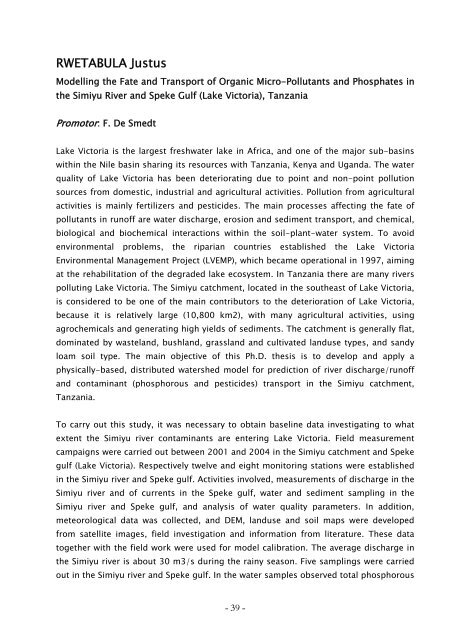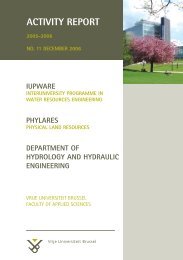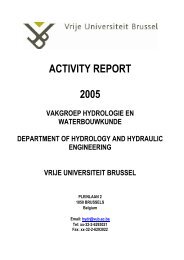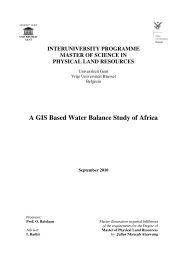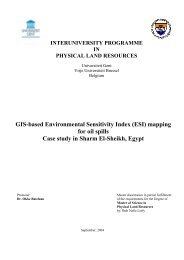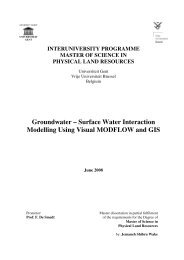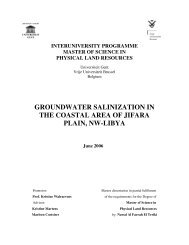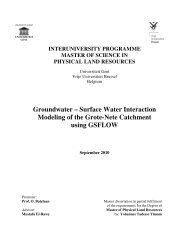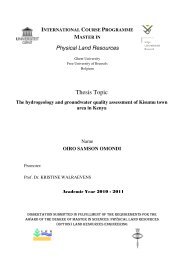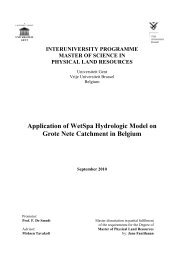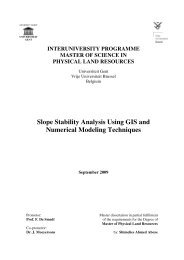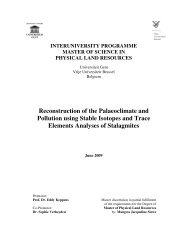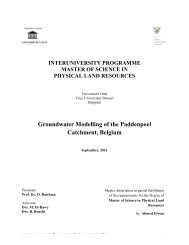C O N T E N T S - Physical Land Resources - Vrije Universiteit Brussel
C O N T E N T S - Physical Land Resources - Vrije Universiteit Brussel
C O N T E N T S - Physical Land Resources - Vrije Universiteit Brussel
Create successful ePaper yourself
Turn your PDF publications into a flip-book with our unique Google optimized e-Paper software.
RWETABULA JustusModelling the Fate and Transport of Organic Micro-Pollutants and Phosphates inthe Simiyu River and Speke Gulf (Lake Victoria), TanzaniaPromotor: F. De SmedtLake Victoria is the largest freshwater lake in Africa, and one of the major sub-basinswithin the Nile basin sharing its resources with Tanzania, Kenya and Uganda. The waterquality of Lake Victoria has been deteriorating due to point and non-point pollutionsources from domestic, industrial and agricultural activities. Pollution from agriculturalactivities is mainly fertilizers and pesticides. The main processes affecting the fate ofpollutants in runoff are water discharge, erosion and sediment transport, and chemical,biological and biochemical interactions within the soil-plant-water system. To avoidenvironmental problems, the riparian countries established the Lake VictoriaEnvironmental Management Project (LVEMP), which became operational in 1997, aimingat the rehabilitation of the degraded lake ecosystem. In Tanzania there are many riverspolluting Lake Victoria. The Simiyu catchment, located in the southeast of Lake Victoria,is considered to be one of the main contributors to the deterioration of Lake Victoria,because it is relatively large (10,800 km2), with many agricultural activities, usingagrochemicals and generating high yields of sediments. The catchment is generally flat,dominated by wasteland, bushland, grassland and cultivated landuse types, and sandyloam soil type. The main objective of this Ph.D. thesis is to develop and apply aphysically-based, distributed watershed model for prediction of river discharge/runoffand contaminant (phosphorous and pesticides) transport in the Simiyu catchment,Tanzania.To carry out this study, it was necessary to obtain baseline data investigating to whatextent the Simiyu river contaminants are entering Lake Victoria. Field measurementcampaigns were carried out between 2001 and 2004 in the Simiyu catchment and Spekegulf (Lake Victoria). Respectively twelve and eight monitoring stations were establishedin the Simiyu river and Speke gulf. Activities involved, measurements of discharge in theSimiyu river and of currents in the Speke gulf, water and sediment sampling in theSimiyu river and Speke gulf, and analysis of water quality parameters. In addition,meteorological data was collected, and DEM, landuse and soil maps were developedfrom satellite images, field investigation and information from literature. These datatogether with the field work were used for model calibration. The average discharge inthe Simiyu river is about 30 m3/s during the rainy season. Five samplings were carriedout in the Simiyu river and Speke gulf. In the water samples observed total phosphorous- 39 -


